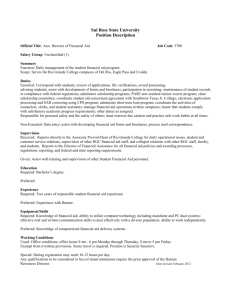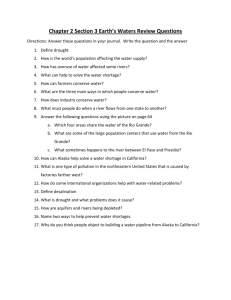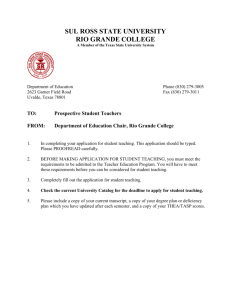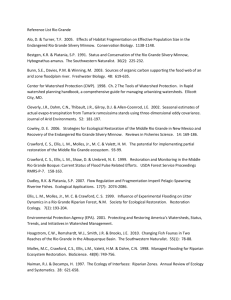How Great a Thirst? Assembling a River Restoration Toolkit Steve Harris
advertisement
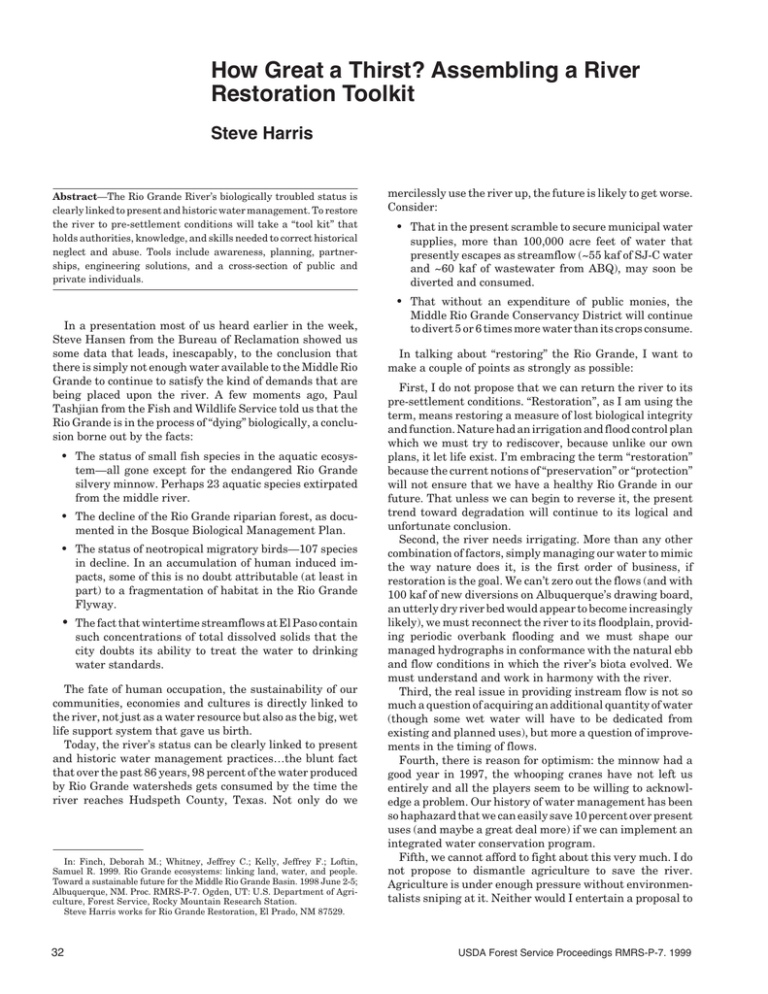
How Great a Thirst? Assembling a River Restoration Toolkit Steve Harris Abstract—The Rio Grande River’s biologically troubled status is clearly linked to present and historic water management. To restore the river to pre-settlement conditions will take a “tool kit” that holds authorities, knowledge, and skills needed to correct historical neglect and abuse. Tools include awareness, planning, partnerships, engineering solutions, and a cross-section of public and private individuals. In a presentation most of us heard earlier in the week, Steve Hansen from the Bureau of Reclamation showed us some data that leads, inescapably, to the conclusion that there is simply not enough water available to the Middle Rio Grande to continue to satisfy the kind of demands that are being placed upon the river. A few moments ago, Paul Tashjian from the Fish and Wildlife Service told us that the Rio Grande is in the process of “dying” biologically, a conclusion borne out by the facts: • The status of small fish species in the aquatic ecosystem—all gone except for the endangered Rio Grande silvery minnow. Perhaps 23 aquatic species extirpated from the middle river. • The decline of the Rio Grande riparian forest, as documented in the Bosque Biological Management Plan. • The status of neotropical migratory birds—107 species in decline. In an accumulation of human induced impacts, some of this is no doubt attributable (at least in part) to a fragmentation of habitat in the Rio Grande Flyway. • The fact that wintertime streamflows at El Paso contain such concentrations of total dissolved solids that the city doubts its ability to treat the water to drinking water standards. The fate of human occupation, the sustainability of our communities, economies and cultures is directly linked to the river, not just as a water resource but also as the big, wet life support system that gave us birth. Today, the river’s status can be clearly linked to present and historic water management practices…the blunt fact that over the past 86 years, 98 percent of the water produced by Rio Grande watersheds gets consumed by the time the river reaches Hudspeth County, Texas. Not only do we In: Finch, Deborah M.; Whitney, Jeffrey C.; Kelly, Jeffrey F.; Loftin, Samuel R. 1999. Rio Grande ecosystems: linking land, water, and people. Toward a sustainable future for the Middle Rio Grande Basin. 1998 June 2-5; Albuquerque, NM. Proc. RMRS-P-7. Ogden, UT: U.S. Department of Agriculture, Forest Service, Rocky Mountain Research Station. Steve Harris works for Rio Grande Restoration, El Prado, NM 87529. 32 mercilessly use the river up, the future is likely to get worse. Consider: • That in the present scramble to secure municipal water supplies, more than 100,000 acre feet of water that presently escapes as streamflow (~55 kaf of SJ-C water and ~60 kaf of wastewater from ABQ), may soon be diverted and consumed. • That without an expenditure of public monies, the Middle Rio Grande Conservancy District will continue to divert 5 or 6 times more water than its crops consume. In talking about “restoring” the Rio Grande, I want to make a couple of points as strongly as possible: First, I do not propose that we can return the river to its pre-settlement conditions. “Restoration”, as I am using the term, means restoring a measure of lost biological integrity and function. Nature had an irrigation and flood control plan which we must try to rediscover, because unlike our own plans, it let life exist. I’m embracing the term “restoration” because the current notions of “preservation” or “protection” will not ensure that we have a healthy Rio Grande in our future. That unless we can begin to reverse it, the present trend toward degradation will continue to its logical and unfortunate conclusion. Second, the river needs irrigating. More than any other combination of factors, simply managing our water to mimic the way nature does it, is the first order of business, if restoration is the goal. We can’t zero out the flows (and with 100 kaf of new diversions on Albuquerque’s drawing board, an utterly dry river bed would appear to become increasingly likely), we must reconnect the river to its floodplain, providing periodic overbank flooding and we must shape our managed hydrographs in conformance with the natural ebb and flow conditions in which the river’s biota evolved. We must understand and work in harmony with the river. Third, the real issue in providing instream flow is not so much a question of acquiring an additional quantity of water (though some wet water will have to be dedicated from existing and planned uses), but more a question of improvements in the timing of flows. Fourth, there is reason for optimism: the minnow had a good year in 1997, the whooping cranes have not left us entirely and all the players seem to be willing to acknowledge a problem. Our history of water management has been so haphazard that we can easily save 10 percent over present uses (and maybe a great deal more) if we can implement an integrated water conservation program. Fifth, we cannot afford to fight about this very much. I do not propose to dismantle agriculture to save the river. Agriculture is under enough pressure without environmentalists sniping at it. Neither would I entertain a proposal to USDA Forest Service Proceedings RMRS-P-7. 1999 desiccate the river to preserve the status quo; it isn’t working. We must learn to honor all aspects of our heritage: healthy ecosystems and healthy economies. The bad news is that the Rio Grande, like the planet’s biological systems in general is, in the words of the immortal Merle Haggard “rolling downhill like snowball headed for hell.” The good news is that we can still avert the crisis. So we must cling to our hope and not give up, just yet. My assignment today is to convince you that we have a sort of “tool kit”, comprised of all the authorities, knowledge and skills which exist in this region to correct the neglect and abuse we have heaped upon a once-functioning river. In order to restore the Rio Grande, we will need them all. In quenching our various and endless thirsts, we have become accustomed to putting the river at the end of the line. We have deluded ourselves into thinking that a river is nothing more than a supply of water, that the vested needs of downstream users guarantees that here will be ample water in and for the river and that our water rights (mere jottings on paper) equate to water itself. We will have to get over these delusions. It is quite useless to point fingers for the shortsightedness of the past. Besides, there aren’t enough fingers to complete the job. We believed what the engineers of 1890 told us about rivers and, to a lingering extent, act as if we still believe them, despite mounting evidence that nature had a terrific plan for delivering water. Just as we have all had our roles in trying to conquer the river, so we can all be a part of its redemption. It is possible that we will avert the crisis without ever pointing any more fingers, but solutions will only come if we can deploy each of the following tools: Awareness—Since we are aware that we have a critical problem that affects all of us, we must now make certain that none of our actions and none of our inactions is serving to perpetuate the problem. Each of us can and must employ the tool which is our own awareness…and insist that any who remain in denial come along with us. I think we’re beginning to see the end game on water in the Middle Rio Grande. If we wait to accept the great challenge until the crisis is actually upon us, we will have already lostfirst the river, then the farm and then the house. There won’t be any Animas River water or Lake Superior water or iceberg towing projects to bail us out. Another aspect of awareness is our understanding of how the Middle Rio Grande water system works, including the effects of our water manipulations on aquatic habitats. Despite some heroic work by Steve Hansen, the Bureau and the City, we still need to know more about the groundwater-surface water interface, project return flows, evaporation and transpiration from all sources. The Corps, in partnership with a number of agencies is developing URGWOM which promises to provide a look at the hydrologic effects of any number of water management scenarios. This sort of information is a valuable tool. And the ability to do “adaptive management”, develop and undertake practical experiments, monitor results and modify such efforts is an essential tool, enabling us to avoid that common pitfall, “paralysis by analysis”. Planning—Planning is a particularly powerful tool to the degree that it includes both economic and environmental USDA Forest Service Proceedings RMRS-P-7. 1999 interests. The Fish and Wildlife Service put together an unprecedentedly diverse team to write the silvery minnow recovery plan: farmers, water users from upstream and down, along with the biologists and bureaucrats who customarily write recovery plans. In fact this was an experiment. Letting affected economic interests into the species recovery game had never been tried. A good theory, but I’m not sure that it worked; I’m not sure that everyone was fully engaged toward the main goal, which was to recover the minnow. Now, we have the Middle Rio Grande Regional Water Planning effort, with 35 stakeholder representatives attending meetings. So far, it seems that the same sort of dynamic prevails: the large water users are watching and waiting and ready to bail out if the outcome doesn’t exactly suit them. Right now, the regional plan is some distance from acknowledging all of the complexities. Additionally, these sorts of plans need to have their implementation written right into them. Producing a document is only half the battle. As Bob Ohmart says: “when all is said and done, a lot more gets said than gets done”. I sense, though, that everyone in the Middle Rio Grande is getting the idea that we really can’t go on like this and that critical regional planning will eventually find its legs and begin to walk. Partnership—It goes by many names: sharing the load, listening to the other person, fairness, reciprocity, cooperation, collaboration. Those of us who are, or have been, married know that this can be a hard tool to get sharp. Everyone has their own interests at heart and nobody can defend my interests better than me and mine. So part of partnership is being fierce in the defense of one’s own interests; the other part is to respect the values of others. This is where partnership gets tricky. To work together requires that we have a common experience, interest or goal, which in this case is the sustainability of our communities, farms and ecosystems. In varying degrees and proportions we all do value and respect these things. To answer the river restoration challenge, we must all be willing to consider viewpoints we are currently uncomfortable with. Today’s paradigm for governance is that I can defeat my adversary’s initiatives as easily as he can defeat mine. When gridlock ensues, everyone loses. The proper goal of partnership in the Middle Rio Grande is that no one loses. We may forego the “thrill of victory”, but we will eliminate the “agony of defeat.” Plumbing—I’m going to suggest that engineering projects, the very tools that got the river into its present state may also serve to get us out of this mess. For example, there’s 2-300 kaf of what appears to be federally-owned water, undelivered San Juan-Chama water in storage in Heron Reservoir. In 1996, it was proven that if the Bureau feels it has the authority to do so, it can pass water through El Vado, Abiquiu and Cochiti for environmental purposes. I must also point out that, once that water is in the river, it’s going downstream to ring the bell at Elephant Butte and satisfy our obligation to Texas…unless, of course, it’s intercepted. We’ve also got this maze of canals and drains and acequias and subsurface seeps that is the MRGCD system. This is 75 year old plumbing, the inefficiencies of which are demonstrated by the fact that the District diverts 5 or 6 acre-feet 33 for each acre foot consumed by the crop. Chief Engineer Shah tells me that much of this excess is necessary to get enough head to push water through portions of the system, particularly the highline canals. This raises the possibility of reducing diversions by reengineering portions of the District’s delivery system. Thus, the draglines and loaders and dozers so loathed by environmentalists could be a very powerful tool for restoring the hydrograph. In putting forward our own Middle Rio Grande Plan, yesterday, an Alliance of river protection advocates suggested that we would be willing to lead, or join, an appeal to Congress for the vey significant funding these sorts of projects will require. People—Throughout the upper Rio Grande Basin, community members are demonstrating that they care very much about the future of the river. I’m pleased to note that Alamosa, Colorado and Socorro, New Mexico and El Paso, Texas each have major projects underway, each aiming to restore hundreds of acres of river banks and riparian wetlands to some semblance of a functioning condition. This tells me that thousands within the basin are willing to devote their energies to the river, against long odds. I wonder how may more would express their loving concern for the river if we could offer them strong hope of success? I’m convinced that the majority of the 10 million folks with whom we share the Rio Grande possess some sense of the river’s importance to the long term survival of our region. 34 I hope I’ve left you with my own sense that we have a lot of the tools we need: the incentive (survival), the engineering (water storage), the raw materials (remnant areas of biodiversity), the knowledge (or the means to acquire it)—to restore the Rio Grande. If the stakeholders, the City, the District, their ratepayers, the Bureau, the pueblos, the OSE/ISC, environmental groups and others, demonstrate that we can bite the bullet, accept the responsibility, sit down and tackle this together, then our legislative bodies will not deny us the financial means. References _____________________ Brookes, Channelized Rivers. Wiley, 1988 Collier, and others, Dams and Rivers: Primer on Downstream Effects of Dams. USGS Circular # 1126, 1996 Clark, Water in New Mexico: A History of its Management and Use, UNM Press, 1987 Crawford, and others, Middle Rio Grande Ecosystem: Bosque Biological Management Plan. USFWS, 1993 Daves, and others, City of Albuquerque Water Resources Management Strategy, 1997 DuMars and Nunn, eds., Middle Rio Grande Conservancy District Water Policies Plan, 1993 DeGraaf and Rappole, Neotropical Migratory Birds. Cornell, 1995 Hansen, and others, Middle Rio Grande Water Assessment. USBR, 1997 Petts and Calow, River Restoration. Blackwell, 1996 Philippi, Floodplain Management-Ecologic and Economic Perspectives. Academic, 1996 Rosgen, Applied River Morphology. Wildland Hydrology, 1996 Whitney, and others, Rio Grande Silvery Minnow Recovery Plan. USFWS, 1998 USDA Forest Service Proceedings RMRS-P-7. 1999



